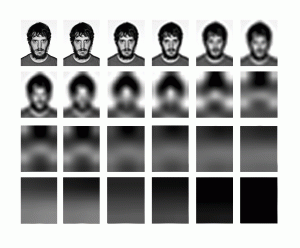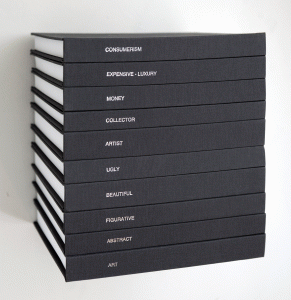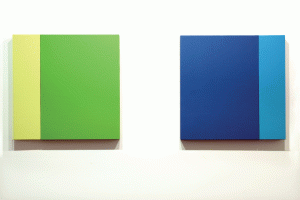« Features
DIALOGUES FOR A NEW MILLENNIUM: EMILIO CHAPELA

Emilio Chapela, Digital Degradation, 2009, polyptych of 50 / inkjet on paper. Courtesy of EDS Galeria/Mexico City.
ASK GOOGLE…
If we think of an artist whose work analyzes our technological, media and internet-based society in a critical and challenging manner, the name of young Mexican artist Emilio Chapela Perez (1978, Mexico City) easily comes to mind. Communication, interpretation, and translation are key concepts in an original artistic practice that both formally and conceptually revolves around the juxtaposition physicality-absence.
By Paco Barragán
Paco Barragán -Emilio Chapela Pérez who is?1
Emilio Chapela Pérez - Emilio Chapela Pérez is an artist of the city of Mexico, to an academic formation in mathematics and communication, their work is related to different scientific concepts, the use of methodologic systems and a constant exploration of the abstract thing. Its work investigates also, the relation, which we with certain technological tools such as Internet and google manufacture, and its effects in human communication.
P.B. - This “gibberish” as you called it is very funny, if it were not for the fact that many people recur in a non-critical manner both to the contents in many websites, and, secondly, to translation tools like Google Translator. Actually, your interview with curator Kóan Jeff Baysa is very illustrative.
E.C.P. - Google translator is used for “practical” problems on a daily basis, and it has become a very useful tool for many people. Actually, it’s becoming harder for me to “fool” the translator into generating gibberish and nonsense. It is a very effective algorithm, but it has an insurmountable limitation: the computer’s inability for interpretation. Without interpretation, there is no translation. Literal translation is fun, but not practical. Understanding this, I’m interested in testing the algorithm’s efficiency by pushing its limits, to generate a new meaning, not just simple gibberish.

According to Google (detail), 2008, digital Offset books, 120 x 30 x 25 cm. Courtesy of EDS Galeria/Mexico D.F.
DIGITAL COLLECTIVE UNCONSCIOUSNESS
P.B. - In this sense, an important part of your work is inspired on the World Wide Web, the Internet, hyper-text… Ask Google, or The Encycopledia According to Google are some of these works through which you try to apprehend the idiosyncrasy of this new society and how it expresses itself. You even talked about a “digital collective unconsciousness.”
E.C.P. - I think we all leave a trace on the Internet, most of the time unconsciously. For example, when you search for something on the Web, you leave a trace which Google picks up and suggests to other users later on. When you upload an image, write on your blog or tweet about your status, you leave another trace. But when you start to look into these evidences (indexes) on a larger scale, you realize that they are a reflection of a collectivity that expresses itself, even without wanting to.
The piece According to Google deals with this: When you use Google to do a query, you obtain time-specific results that you can understand and analyze methodically, but if you perform the same search on the next day, the results will have changed. For the first book I did for this piece, I searched for the word “beautiful” and compiled all the images I found in a single book: I was amazed to discover how many images of guns appeared in the query. I think this speaks very clearly of what a portion of society feels about beauty.
I’m very excited about the Ask Google project; it is amazing how being anonymous frees you from self-censorship and brings out your “true colors.” It is very shocking to me to see what people “ask” Google about. It can be very politically incorrect, and even scary.
P.B. - Other text-based works like Language, Consistency, Dialogue/Robot affirm this “nonsensical element” that emerges when a language is being translated in particular, and the contradictions of communication in general. There is this linguistic element that strongly informs your artistic practice, both from a formal and also conceptual point of view, that has its roots both in artistic movements like Minimalism and Conceptualism, but also in theories like Post-structuralism and Semiotics.
E.C.P. - That’s correct, especially for the translation pieces. I’m not interested in destroying meaning just for the sake of it. I think more in terms of deconstruction, which is an idea that comes from Post-structuralism or Post-modernism. I like to think that a work like Language constructs a new, different, mutated meaning as a consequence of the computer translation.
I’m also very interested in hermeneutics, interpretation and translation processes in general, and I like conceptualism because it presents very simple solutions, but quite strong, deep and smart ones.
P.B. - Works like One and fifty chairs, Crisis, and Spectacular can be seen as ironic re-readings of Kosuth and Nauman. Let’s talk about a piece that I always liked very much: Spectacular…But Empty. Is this a critique of society in general, and the art world in particular?
E.C.P. - It started as a critique of the art world, but I think it became more complex and more general than that. On the one hand, it is a reference to Guy Debord’s Society of the Spectacle, but it is also related to mathematics as well, to the idea of recursiveness and self-reference. It is a kind of oxymoron.
I started thinking about the piece while walking around the gallery district in Chelsea: Everything looked so big, shiny and spectacular, but nothing really interested me. I like spectacular things, but also works that are multi-layered. Then, I decided to make a spectacular piece that made a critical comment on “spectacularization,”a piece trapped inside its own argument. I used neon because it is spectacular and beautiful by nature (like fireworks), and not so much because of Nauman’s work. On the contrary, my piece One and fifty Chairs is actually a very direct reference to Kosuth’s work.
P.B. - On the other hand, you also conceived a work like Patience in which you perform in front of a video stamping the word “patience” 500 times in an empty book. This is interesting because we see more and more artists eschewing this crazy and restless media and techno-driven society and pursuing works that are “slow” paced and minded. How did this piece come about?
E.C.P. - I wanted to slow down a bit. I was feeling a little dispersed artistically, so I decided to engage in this meditative exercise. And I think it worked for me. It got me started on other language-related pieces like Spectacular … but Empty or Consistency.
But there is more to it, as I also feel that there is a constant demand for patience in many aspects of life. We are always being told to wait and not to be too ambitious too fast. I had to make a piece to pace myself, or to be critical? I don’t know, but sometimes I just don’t want to be patient.
MATHEMATICAL ABSTRACTION IN THE REAL WORLD
P.B. - A second part of your work is informed by your interest in abstraction. Many people didn’t know that you had a mathematical background. Is the numerical element in pieces like Seascapes, 256 Drinks or 512 Drinks an index for the endless possibilities of choice in today’s consumerist society?
E.C.P. - That’s correct; those pieces are indexes and they are very related to consumerism. The absurdity of choices in today’s market is really amazing to me; it makes no sense at all. It seems as though there is a product designed for everyone of us. But it is also a very beautiful thing. I like supermarkets and how things are arranged, piled up and classified.
Having a mathematical background has had an influence on most of my work, especially on how I structure things. In this case, it is reflected on my tendency to classify and organize things.These pieces really are about the index and the relationship between photography and painting.

Movistar, 2009, Auto-paint on canvas, Two 20” x 20” in pieces. Courtesy of Galeria Faria + Fabregas/Caracas and EDS Galeria/Mexico City.
P.B. - Unlike American Abstraction, and abstraction in general that was/is more concerned with elements like color, form and other spiritual matters; your abstraction is very mundane and refers to predetermined elements of our daily lives. Good examples are The Corporate Logos series or your most recent series Color Fillds at Faria + Fabregas Galeria in Caracas.
E.C.P. - I think that the “corporate logos” series moves in the opposite direction. They are an effort to connect you back to the world with a very specific urban visual landscape. And for the same reason, they are not about experiencing color and form, but about predetermination. I like to think that the specific colors for these paintings are decided inside a conference room of an advertising company. I also like to lose control; it is like creative relief.
Working for the show at Faria + Fabregas in Venezuela was very challenging because the urban landscape is very different in any part of the world, so I had to work with logos that had some impact or relationship to Caracas’ urban landscape. It was interesting to do the work as an “outsider.”
P.B. - These compositions display an interesting juxtaposition between form and concept: they have the appearance of minimalist, cold abstract paintings; while, at the same time, they tackle conceptually hot, everyday, and close topics for the viewer -in this case logos and brands. Where does this interest in linking the abstract to the concrete come from?
E.C.P. - I started doing art as a photographer, and I was always interested in the indexical nature of photography and its relation with abstraction. In pieces like 512 Drinks the photographic process is very important, because it links the abstract image to the product itself. The photography is the index. Then, I started to think about abstract painting and studying Gerhard Richter, Ellsworth Kelly and Abstract Expressionism, until I left photography behind. But my interest in the index remained along with the strategy for linking the abstract to the everyday world, to the mundane. The titles of the works are very important in this sense, as they are very descriptive, which helps the viewer make the link back to the concrete.
P.B. - We could again sense here, as in your Internet-based works, a search for a collective unconsciousness, but in this case of a more visual sort?
E.C.P. - Exactly! Corporate logos are part of our everyday visual landscape; looking at them becomes the natural thing. We see them so much that they get into our heads and remain there as latent images. I’m interested in exploring how that visual collective unconsciousness is configured. Most of the paintings look really familiar when you see them, but you don’t recognize where they come from. I like that moment of ambiguity. Then you read the title, which is the name of the logo itself, and something clicks.
P.B. - We could conclude that your artistic practice is fuelled by the dichotomy “physicality-absence.” Your self-portrait Digital Degradation could be a perfect example of it.
E.C.P.- Yes, I agree. I didn’t think about that before. But it is definitely possible to establish the analogy you are a suggesting between my body of work and that specific piece. Digital Degradation is like a disappearing act. It’s a portrait that becomes a landscape, and it moves exactly in that direction: from the physical to the ethereal; from the concrete to the abstract; and from presence to absence.
P.B. - Was a pleasure speaking with you… 2
Notes
1 The first question and answer of this interview were translated from Spanish utilizing Yahoo Babel Fish Translator. The use of this translation tool on the part of the interviewer and the artist is intentional. It is intended to show the current indiscriminate usage of online translation resources, which lack quality and contribute to the dissemination of erroneous information.
2 Translated from Spanish by Yahoo Babel Fish Translator.
Paco Barragán is an independent curator and an arts writer based in Madrid. He has most recently curated “The Non Age,” Kunsthalle Winterthur and “Marc Bijl. Arrested Development,” Domus Artium 2 (DA2), Salamanca. 2002; and published The Art Fair Age, CHARTA, 2008; and Sustainabilities, CHARTA, 2008, a series of essays by leading contemporary thinkers, such as Slavoj Žižek, Simon Critchley and Gilles Lipovetsky.


































